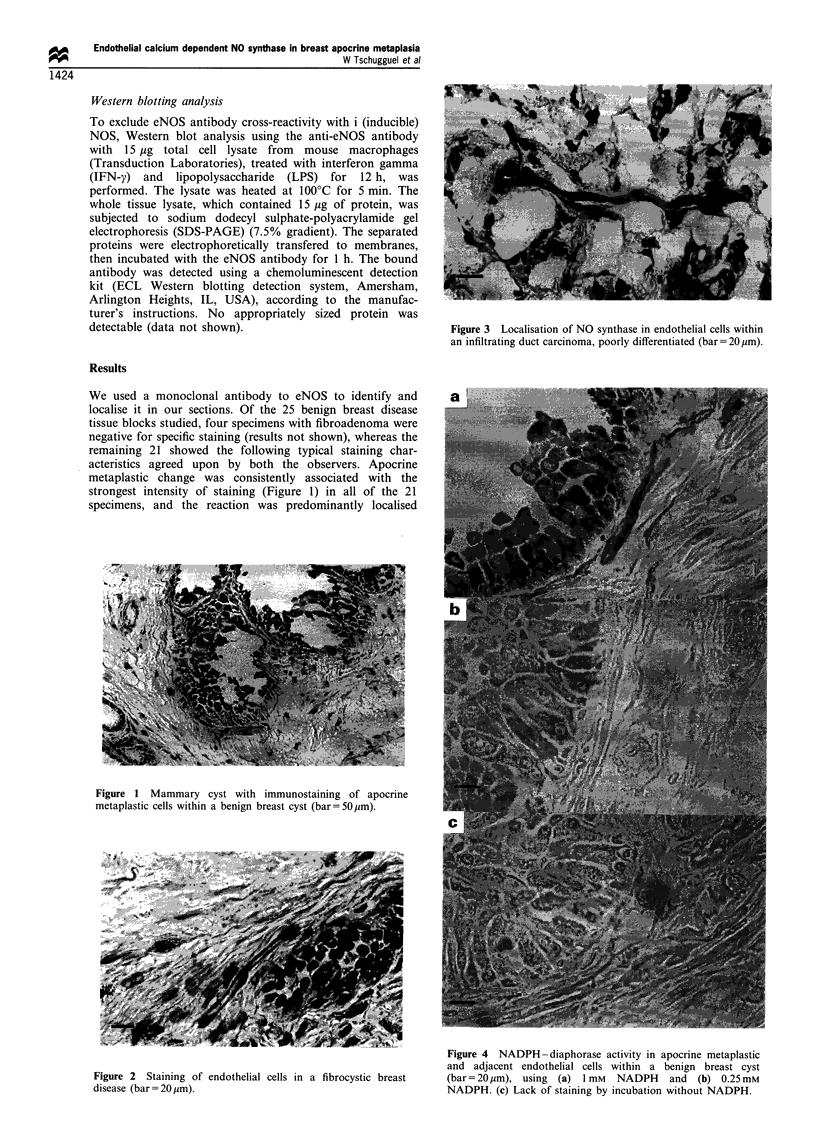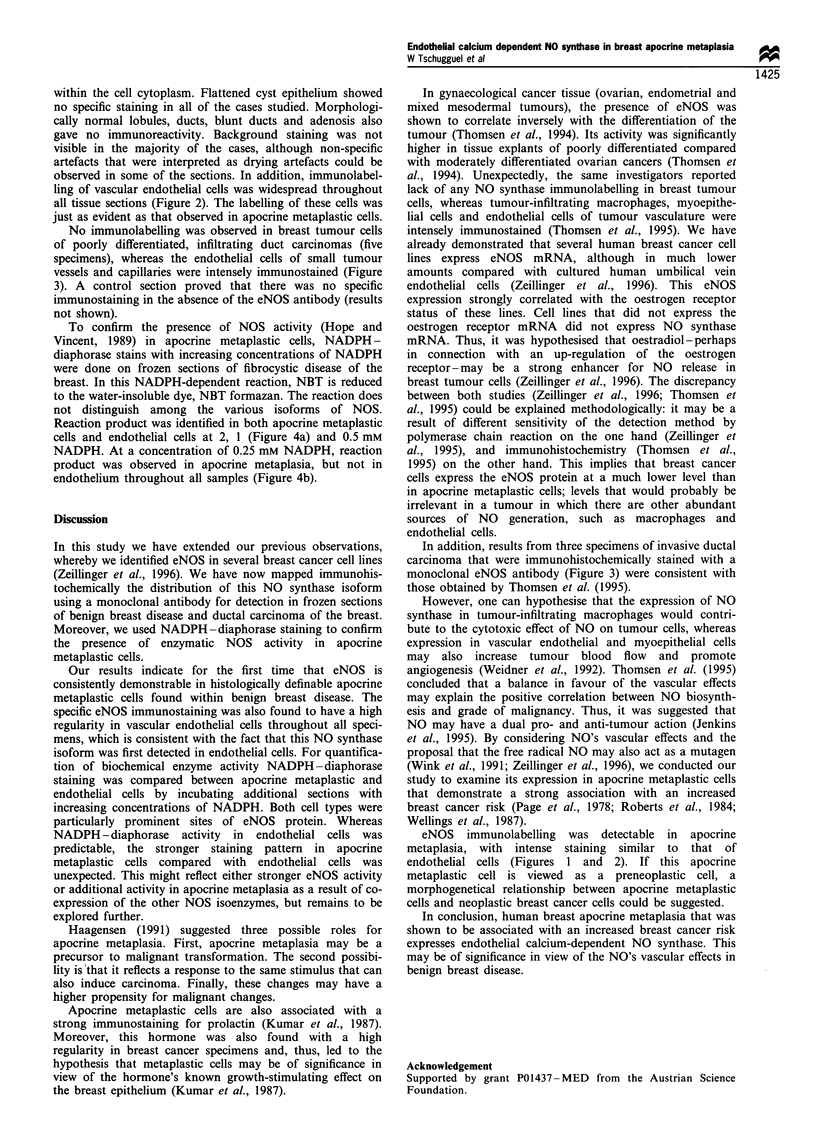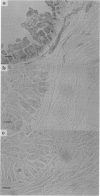Abstract
Endothelial calcium-dependent nitric oxide (NO) synthase has been shown to be expressed in human malignant breast tumours, and its presence correlates with tumour grade. Moreover, NO, being synthesised in breast tumour cells, may increase tumour blood flow and promote angiogenesis. In view of these aspects, we have assessed the distribution of NO synthase within a series of benign breast tumours using a monoclonal antibody against human endothelial calcium-dependent NO synthase. Activity was predominantly localised in apocrine metaplastic cells of fibrocystic disease, as well as in endothelia throughout all tissue sections. Consistent with previous reports, no endothelial calcium-dependent NO synthase immunoreactivity was observed in poorly differentiated infiltrating duct carcinoma cells. In conclusion, expression of endothelial calcium-dependent NO synthase in human breast apocrine metaplasia may be of significance in view of the NO's vascular effects in benign breast disease.
Full text
PDF



Images in this article
Selected References
These references are in PubMed. This may not be the complete list of references from this article.
- Andrade S. P., Hart I. R., Piper P. J. Inhibitors of nitric oxide synthase selectively reduce flow in tumor-associated neovasculature. Br J Pharmacol. 1992 Dec;107(4):1092–1095. doi: 10.1111/j.1476-5381.1992.tb13412.x. [DOI] [PMC free article] [PubMed] [Google Scholar]
- Dinerman J. L., Dawson T. M., Schell M. J., Snowman A., Snyder S. H. Endothelial nitric oxide synthase localized to hippocampal pyramidal cells: implications for synaptic plasticity. Proc Natl Acad Sci U S A. 1994 May 10;91(10):4214–4218. doi: 10.1073/pnas.91.10.4214. [DOI] [PMC free article] [PubMed] [Google Scholar]
- Dixon J. M., Lumsden A. B., Miller W. R. The relationship of cyst type to risk factors for breast cancer and the subsequent development of breast cancer in patients with breast cystic disease. Eur J Cancer Clin Oncol. 1985 Sep;21(9):1047–1050. doi: 10.1016/0277-5379(85)90289-5. [DOI] [PubMed] [Google Scholar]
- Förstermann U., Closs E. I., Pollock J. S., Nakane M., Schwarz P., Gath I., Kleinert H. Nitric oxide synthase isozymes. Characterization, purification, molecular cloning, and functions. Hypertension. 1994 Jun;23(6 Pt 2):1121–1131. doi: 10.1161/01.hyp.23.6.1121. [DOI] [PubMed] [Google Scholar]
- Haagensen D. E., Jr Is cystic disease related to breast cancer? Am J Surg Pathol. 1991 Jul;15(7):687–694. doi: 10.1097/00000478-199107000-00010. [DOI] [PubMed] [Google Scholar]
- Hope B. T., Vincent S. R. Histochemical characterization of neuronal NADPH-diaphorase. J Histochem Cytochem. 1989 May;37(5):653–661. doi: 10.1177/37.5.2703701. [DOI] [PubMed] [Google Scholar]
- Jenkins D. C., Charles I. G., Thomsen L. L., Moss D. W., Holmes L. S., Baylis S. A., Rhodes P., Westmore K., Emson P. C., Moncada S. Roles of nitric oxide in tumor growth. Proc Natl Acad Sci U S A. 1995 May 9;92(10):4392–4396. doi: 10.1073/pnas.92.10.4392. [DOI] [PMC free article] [PubMed] [Google Scholar]
- Kumar S., Mansel R. E., Jasani B. Presence and possible significance of immunohistochemically demonstrable prolactin in breast apocrine metaplasia. Br J Cancer. 1987 Mar;55(3):307–309. doi: 10.1038/bjc.1987.60. [DOI] [PMC free article] [PubMed] [Google Scholar]
- Page D. L., Vander Zwaag R., Rogers L. W., Williams L. T., Walker W. E., Hartmann W. H. Relation between component parts of fibrocystic disease complex and breast cancer. J Natl Cancer Inst. 1978 Oct;61(4):1055–1063. [PubMed] [Google Scholar]
- Roberts M. M., Jones V., Elton R. A., Fortt R. W., Williams S., Gravelle I. H. Risk of breast cancer in women with history of benign disease of the breast. Br Med J (Clin Res Ed) 1984 Jan 28;288(6413):275–278. doi: 10.1136/bmj.288.6413.275. [DOI] [PMC free article] [PubMed] [Google Scholar]
- Thomsen L. L., Lawton F. G., Knowles R. G., Beesley J. E., Riveros-Moreno V., Moncada S. Nitric oxide synthase activity in human gynecological cancer. Cancer Res. 1994 Mar 1;54(5):1352–1354. [PubMed] [Google Scholar]
- Thomsen L. L., Miles D. W., Happerfield L., Bobrow L. G., Knowles R. G., Moncada S. Nitric oxide synthase activity in human breast cancer. Br J Cancer. 1995 Jul;72(1):41–44. doi: 10.1038/bjc.1995.274. [DOI] [PMC free article] [PubMed] [Google Scholar]
- Weidner N., Folkman J., Pozza F., Bevilacqua P., Allred E. N., Moore D. H., Meli S., Gasparini G. Tumor angiogenesis: a new significant and independent prognostic indicator in early-stage breast carcinoma. J Natl Cancer Inst. 1992 Dec 16;84(24):1875–1887. doi: 10.1093/jnci/84.24.1875. [DOI] [PubMed] [Google Scholar]
- Wellings S. R., Alpers C. E. Apocrine cystic metaplasia: subgross pathology and prevalence in cancer-associated versus random autopsy breasts. Hum Pathol. 1987 Apr;18(4):381–386. doi: 10.1016/s0046-8177(87)80169-7. [DOI] [PubMed] [Google Scholar]
- Wink D. A., Kasprzak K. S., Maragos C. M., Elespuru R. K., Misra M., Dunams T. M., Cebula T. A., Koch W. H., Andrews A. W., Allen J. S. DNA deaminating ability and genotoxicity of nitric oxide and its progenitors. Science. 1991 Nov 15;254(5034):1001–1003. doi: 10.1126/science.1948068. [DOI] [PubMed] [Google Scholar]
- Zeillinger R., Tantscher E., Schneeberger C., Tschugguel W., Eder S., Sliutz G., Huber J. C. Simultaneous expression of nitric oxide synthase and estrogen receptor in human breast cancer cell lines. Breast Cancer Res Treat. 1996;40(2):205–207. doi: 10.1007/BF01806216. [DOI] [PubMed] [Google Scholar]






